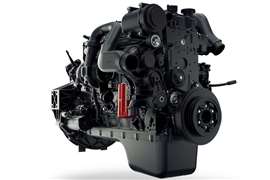Read this article in 中文 Français Deutsch Italiano Português Español
FPT Industrial, Stanadyne talk IC engine innovation
27 October 2024
A recent Engine Technology Forum (ETF) webinar focused on the various innovations being made in internal combustion (IC) engines to address engine efficiency as well as emissions. Industry speakers addressed topics ranging from fuels to aftertreatment.
A significant portion of the webinar, however, was focused on technological advancements in the IC engines themselves.
Kicking off that part of the webinar was Ivan Tate, technical center director at engine and powertrain manufacturer FPT Industrial. He reviewed the innovations FPT has made in the interest of addressing performance, fuel consumption and productivity.
Calling the internal combustion engine “a prime mover for a number of years to come,” Tate focused specifically on FPT’s 13 L XC13 engine platform, which can be configured for multiple fuels. These include diesel and natural gas, both of which were central to his remarks.
Engine Evolution
Tate discussed the evolution of the XC13, starting with the Cursor C13 in 1998.
 FPT Industrial’s XC13 unveiled at IAA Transportation 2022. (Photo: FPT Industrial)
FPT Industrial’s XC13 unveiled at IAA Transportation 2022. (Photo: FPT Industrial)
“Conceived as an on-highway engine, we made the step into off-highway in the early 2010s,” he said. “There was an increase of power — dual-stage turbocharging. Then your heavy legislation changes start to come in around that time (2012). It evolved into natural gas (2017), and then as a company, we kind of recognized what was happening now. So, the Cursor X concept (2018) — we were really looking at sustainability, modularity and flexibility of our products. And the XC13 is really the new generation here.”
One common innovation FPT chose for the XC13 regardless of fuel type was to migrate from standard castings for the cylinder block and head to compacted graphite iron (CGI).
“This enables us to be lighter but also more rigid,” he said. “So, that aids emissions and also the amount of cylinder pressure that we can maintain.”
The improvements FPT made reduced weight by about 10 percent on both the diesel and natural gas models compared to the C13 engine.
Friction Reductions
FPT also sought to reduce friction in the XC13 by using new materials on the connecting rods and pins — something Tate called a key development.
“It seems easy,” he said. “Take the bearing surface, improve the materials, reduce the surface area, modify the clearances to optimize the friction. But we’re also looking at serviceability, so increased service intervals, increased load versus previous generations. So, working with lubrication manufacturers, and a lot of durability work needed to be done to action make those benefits come and deliver exactly what we needed there.”
Other improvements in the valve train system increased braking power by 29 percent in the diesel version of the XC13 and more than 300 percent in the natural gas unit — both in relation to the C13 predecessor.
“This in part obviously improves drivability, but it also approaches some of the other emissions that are entering the emissions spectrum,” he said, adding that this includes brake dust and emissions related to component wear that have begun to appear on emissions charts in the wake of significantly lower tailpipe combustion emissions.
Auxiliaries and Controls
Two additional improvements that combined with the lighter engine weight have contributed to performance and fuel consumption are smart auxiliaries and advanced combustion control. The auxiliaries in question are variable-speed oil and water pumps, which can be either two-step or fully variable, Tate said. From a controls perspective, the XC13 features advanced combustion control and thermal management.
“Particularly in startup conditions, cold conditions and transients, the benefits of fuel injection, being able to control turbocharger back pressures, exhaust back pressures and then change injection patterns reveals the fact that we can increase power, but we can also meet emissions and fuel consumption targets while doing that,” he said.
Compared to the C13, these and other improvements in the XC13 have resulted in a more than 2 percent increase in power and over 12 percent increase in torque in the diesel version with a corresponding 7 percent decrease in fuel consumption. The natural gas model saw increases in power and torque of more than 9 percent and over 10 percent respectively, with a fuel efficiency improvement of about 8 percent.
LPG Direct Injection
Srinu Gunturu, chief engineer for fuel system company Stanadyne, discussed innovations in propane-powered IC engines — particularly direct injection of liquefied petroleum gas (LPG).
 The Stanadyne fuel injector and pump delivers LPG by means of the vapor-lock inhibiting system developed and designed by Katech. (Photo: Stanadyne)
The Stanadyne fuel injector and pump delivers LPG by means of the vapor-lock inhibiting system developed and designed by Katech. (Photo: Stanadyne)
“We believe that it’s going to be a great alternative,” he said, “and also increase the efficiency of the current liquid propane port fuel systems that we have that are available on the market.”
Among the benefits of LPG, Gunturu noted that engine efficiency and emissions improvements.
“The octane rating is 105, and with using a three-way catalyst, probably we can reduce even more on the emissions and also less expensively than the diesel aftermarket systems,” he said. “And because of the liquid propane, you will get into the near-zero particulate matter (PM) on emissions.”
Gunturu cited the work Stanadyne has done with Katech Engineering and the Propane Education & Research Council (PERC) on bringing LPG direct injection to the market.
Addressing Vapor Lock
“We did a system on a GM platform, which is [the] L8T engine, with no major modifications from a gasoline engine — [we] directly changed it to the liquid propane,” he said. “We were able to convert and make some smaller modifications on the software and hardware and to have some vapor lock inhibitors in the system in application form to be able to help fire this engine with the liquid propane.”
Vapor lock was a key issue Stanadyne had to overcome in running the engine on LPG.
“The main obstacle that we had was the fuel,” Gunturu said. “Propane becomes a gas at ambient pressure, and it evaporates in the system.”
Gunturu said modifications were made to the propane pump and injector to address the vapor lock issue.
“We made design changes to our pump along with the system to be able to help that vapor lock with the liquid propane,” he said, “for the delivery from the high-pressure pump, so that the pump won’t seize and operate at higher pressures so that we won’t see that vapor lock. Also, I developed a system of pressure relief just in case there’s any vapor forming in the rail, which will help to eliminate that vapor, as well, to release and attach it back to the chassis side.”
The injectors were also designed to achieve higher flow, Gunturu added, to improve combustion of the LPG in the cylinder.
Comparable to Gasoline
 The General Motors L8T 6.6L GDI test engine was updated with the Stanadyne components and operated on LPG direct injection. (Photo: Stanadyne)
The General Motors L8T 6.6L GDI test engine was updated with the Stanadyne components and operated on LPG direct injection. (Photo: Stanadyne)
According to Gunturu, the L8T engine performed on LPG comparably to the engine running on gasoline. Engine horsepower was slightly higher than the gasoline baseline in the range of 3000 to 3500 rpm.
Stanadyne did dyno testing to ensure that running the engine on LPG would not damage or destroy the engine, cylinder heads and other mechanical components.
“We haven’t seen any sign of abnormal mechanical wear or valve seat recession — also any issues with the fuel pumps or fuel injectors,” Gunturu said, adding that this is after more than 16 million cycles on the injectors and over 50 million fuel pump strokes. “And not only just running steady-state. We ran transient cycle with different start/stop conditions, cold start conditions, as well as 55 to 65 mph cruise testing to be able to see whether this technology was going to have an impact on the reliability or the durability of the engine and also on the fuel system components.”
Future Plans
Stanadyne is looking into whether the technology can leverage renewable dimethyl ether (rDME) blends as well as renewable propane.
Gunturu added that Stanadyne has plans to convert a GM truck with a 5.3L V8 engine to run on LPG.
“We are planning to complete the entire full-blown EPA emissions testing to prove that you will have a measurable benefit of CO2 and also a lot of emissions reductions that you’ll see that are next steps to take this to the next level for the market.”
POWER SOURCING GUIDE
The trusted reference and buyer’s guide for 83 years
The original “desktop search engine,” guiding nearly 10,000 users in more than 90 countries it is the primary reference for specifications and details on all the components that go into engine systems.
Visit Now
STAY CONNECTED




Receive the information you need when you need it through our world-leading magazines, newsletters and daily briefings.
CONNECT WITH THE TEAM















